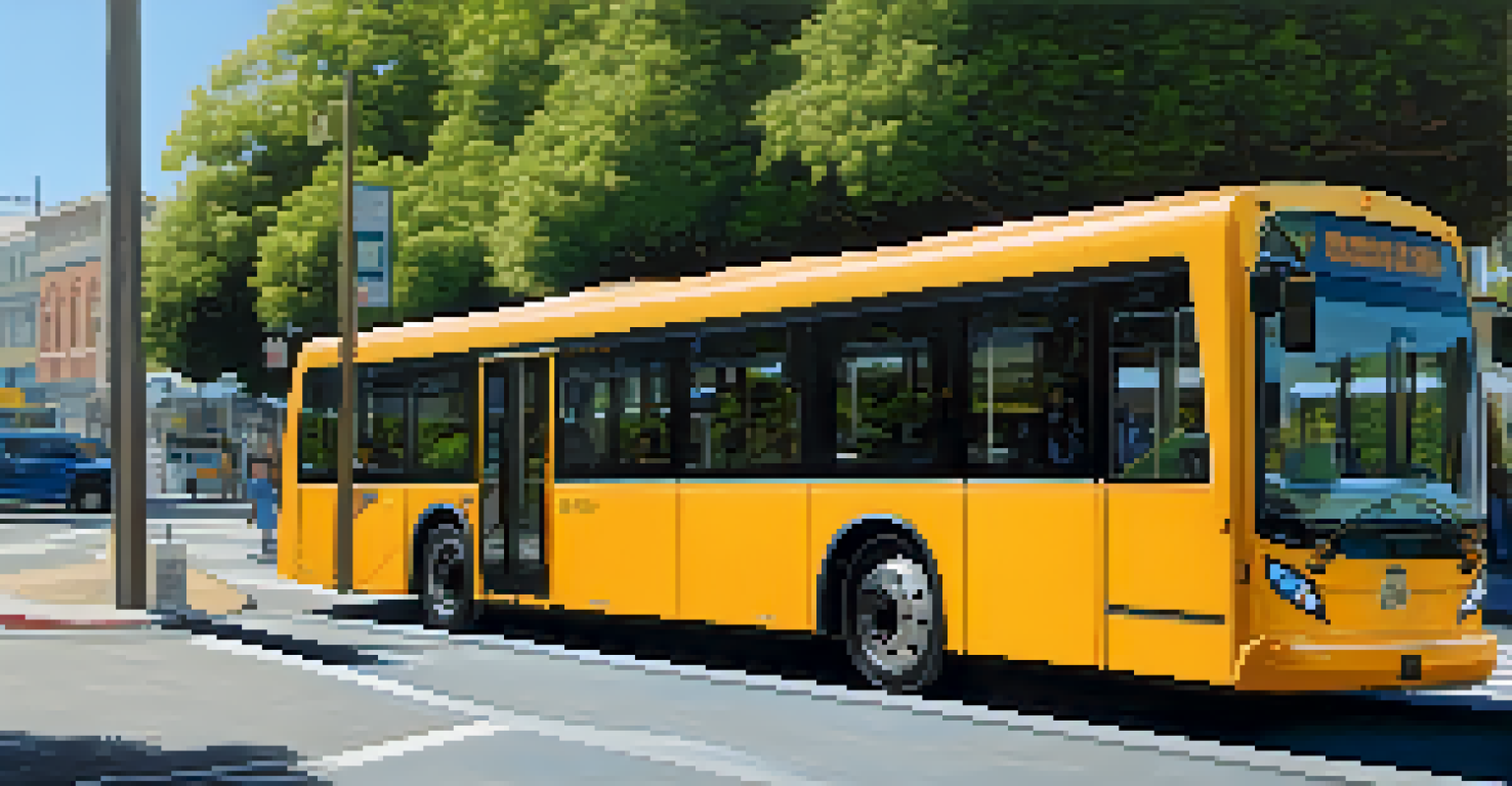Sustainable Transportation: Innovations for a Greener SF

The Importance of Sustainable Transportation in Urban Areas
Sustainable transportation is crucial for urban areas like San Francisco, where the population density can lead to heavy traffic and pollution. By prioritizing eco-friendly transport options, cities can reduce their carbon footprint and improve air quality. This shift not only benefits the environment but also enhances the quality of life for residents.
Sustainable transportation is not just about reducing emissions; it's about creating a better quality of life for everyone in the city.
In San Francisco, the push for sustainability aligns with the city's goals to combat climate change and promote public health. Imagine a city where walking, biking, and public transit are the norm rather than the exception—this is the vision of a greener urban future. The community's collective effort is key to making this vision a reality.
Moreover, sustainable transportation fosters social equity by providing accessible options for all residents, regardless of income. This inclusivity helps create a vibrant urban environment where everyone can thrive, demonstrating that sustainable practices can lead to both environmental and social benefits.
Electric Bicycles: The Future of Urban Mobility
Electric bicycles, or e-bikes, have quickly gained popularity in San Francisco as a convenient and eco-friendly mode of transportation. With their electric assist, e-bikes make hilly terrains more manageable, encouraging more people to opt for biking over driving. This shift not only reduces traffic congestion but also promotes healthier lifestyles.

Many local businesses have started offering e-bike rentals, making it easier for both residents and tourists to explore the city sustainably. Picture cruising along the Embarcadero on an e-bike, enjoying the scenic views without the hassle of parking. It’s an experience that combines fun and fitness while minimizing your carbon footprint.
Sustainable Transport Enhances Urban Life
Prioritizing eco-friendly transportation options can significantly reduce pollution and improve the quality of life in urban areas.
Moreover, e-bikes are part of a broader trend towards micro-mobility solutions that address the unique challenges of urban transportation. As the infrastructure for biking improves, including dedicated lanes and bike-sharing programs, e-bikes will likely become an integral part of San Francisco’s transport landscape.
Public Transit Innovations: Making It More Accessible
San Francisco's public transit system is continually evolving, with innovations aimed at making it more accessible and efficient. Initiatives like the Muni Mobile app allow users to track buses in real-time, making commuting less stressful. This digital transformation is a game-changer for both residents and visitors.
The future of our cities depends on how we choose to move within them, and sustainable transportation is key to that future.
Additionally, the city is investing in electric buses, which not only reduce emissions but also provide a quieter, more pleasant ride. Imagine hopping onto a clean, silent bus while knowing you're contributing to a healthier planet. This shift in public transport reflects a strong commitment to sustainability.
The integration of various transport modes, such as buses, trams, and ferries, creates a seamless travel experience. This interconnectedness encourages more people to leave their cars at home, further reducing traffic and pollution. The goal is to create a reliable public transit network that everyone can trust and enjoy.
Car-Sharing Programs: Reducing the Need for Ownership
Car-sharing programs are gaining traction in San Francisco, offering a sustainable alternative to car ownership. These services allow users to rent vehicles for short periods, reducing the number of cars on the road. Imagine having access to a car whenever you need one without the hassle of maintenance and parking.
These programs not only cut down on emissions but also help lessen the congestion that plagues urban areas. With fewer cars in circulation, the city can reclaim valuable space for parks and bike lanes, enhancing urban livability. It’s a win-win for both the environment and the community.
E-bikes Transform Urban Mobility
Electric bicycles are gaining popularity as a convenient and sustainable way to navigate hilly urban terrains, promoting healthier lifestyles.
Moreover, many car-sharing services offer electric vehicles, further supporting the city’s sustainability goals. By choosing to share rather than own, residents can contribute to a greener future while enjoying the flexibility of having a car available when necessary. This shift in mindset is essential for fostering a sustainable urban culture.
Walking and Biking: Promoting Active Transportation
Walking and biking are integral components of sustainable transportation in San Francisco. The city's commitment to improving pedestrian and cyclist infrastructure demonstrates a dedication to creating a more walkable and bike-friendly environment. Think of the joy of strolling through Golden Gate Park or biking along the waterfront—it’s about embracing a healthier lifestyle.
By prioritizing these modes of transport, San Francisco can reduce reliance on cars and decrease overall emissions. The city has expanded bike lanes and pedestrian zones, making it safer and more enjoyable for people to get around on foot or by bike. This not only benefits the environment but also promotes community interaction and well-being.
Community initiatives, such as organized bike rides and walking events, further encourage residents to embrace active transportation. These events foster a sense of community and help individuals discover the joy of exploring their city without a vehicle. Walking and biking can transform how we perceive and interact with our urban landscape.
The Role of Technology in Sustainable Transportation
Technology plays a pivotal role in revolutionizing sustainable transportation in San Francisco. With advancements in apps and smart systems, commuters can access real-time data on transit options, bike availability, and traffic conditions. This information empowers users to make informed decisions that benefit both themselves and the environment.
Innovative solutions, such as ride-sharing algorithms and electric vehicle charging stations, are becoming increasingly commonplace. These technologies optimize travel routes and reduce the time spent searching for parking, making sustainable options more appealing. As technology continues to evolve, it will further enhance the efficiency of urban transport.
Community Engagement Drives Change
Active participation from residents is essential for shaping sustainable transportation initiatives that reflect community values and needs.
Additionally, the integration of artificial intelligence and machine learning can help city planners create more effective transportation strategies. By analyzing patterns in commuting behavior, cities can better allocate resources and improve infrastructure. This data-driven approach ensures that sustainable transport solutions are not only effective but also adaptable to changing needs.
Community Engagement in Sustainable Transportation Initiatives
Community engagement is vital for the success of sustainable transportation initiatives in San Francisco. Local organizations and residents play a crucial role in advocating for greener transport options and shaping city policies. When people come together to voice their needs and ideas, they can drive meaningful change.
Public forums, workshops, and surveys allow residents to participate in the planning process, ensuring that sustainable initiatives reflect the community's values. For instance, feedback from local cyclists has led to the development of more bike lanes and safer routes. This collaborative approach fosters a sense of ownership and pride in the city’s transportation system.

Moreover, educational campaigns about the benefits of sustainable transportation can inspire more residents to make eco-friendly choices. By raising awareness and encouraging participation, communities can create a culture of sustainability that extends beyond transportation. Together, they can pave the way for a greener, more vibrant San Francisco.